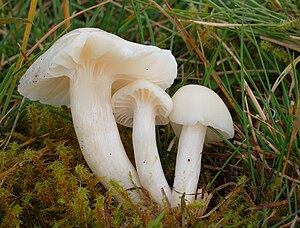Virgin Ellerling
| Virgin Ellerling | ||||||||||||
|---|---|---|---|---|---|---|---|---|---|---|---|---|

Virgin Ellerling ( Cuphophyllus virgineus ) |
||||||||||||
| Systematics | ||||||||||||
|
||||||||||||
| Scientific name | ||||||||||||
| Cuphophyllus virgineus | ||||||||||||
| ( Wulfen ) Kovalenko |
The maiden Ellerling ( Cuphophyllus virgineus , Syn . : Hygrocybe virginea ) is a type of mushroom from the family of the snail relatives . He prefers to grow on poor, mossy grass areas and forms in the fall of small, largely monochrome-whitish and partly glassy translucent fruiting bodies , which is why the fungus as Glasig- or Snow White Ellerling is called. It is edible.
features

Macroscopic features
The fruiting bodies usually grow in groups. The thin-fleshed hat measures 1.5-3 (-5) cm in diameter and is arched when young, later flat or slightly depressed in the middle and can have a slight hump. The surface is (ivory) white and changes color easily in damp weather ( hygrophanity ). The edges are transparently grooved when moist. The thick, waxy, creamy-white colored lamellae are distant and run down the handle. Their edges are smooth. The stalk becomes 2–5 (–6) cm long and 3–5 mm thick. It is largely cylindrical in shape and pointed at the lower end. Inside it is initially full-fleshed, but later stuffed or hollow. On the outside it is smooth, hat-colored and sometimes also colored +/- pink-brown at the base. The watery meat is odorless and tastes mild. The spore powder is white and shows no color reaction with iodine reagents ( inamyloid ).
Microscopic features
The superficially smooth spores measure 7-11 × 4-5.5 micrometers and are more or less elliptical in shape. The hat skin is a thin ixocutis .
Species delimitation
The Juchten Ellerling ( Cuphophyllus russocoriaceus ), which cannot be recommended as an edible mushroom, is very similar . It differs well by its fine smell of Russian leather . The similar White Meadow Ellerling ( Cuphophyllus pratensis var. Pallidus ) typically has larger fruiting bodies and is not hygrophan. It would be dangerous to mix it up with the potentially fatal field funnel ( Clitocybe dealbata ).
Ecology and phenology
The species probably lives in symbiotic communities with mosses in poor grass areas, preferably in calcareous soils, and in North America in forests.
It fructifies from September to December.
distribution
The maiden Ellerling is widespread in the temperate zone of the northern hemisphere and occurs throughout Europe as well as North America and North Asia, but was also found in Australia. The species is more common than its mostly endangered genus relatives and is not considered to be endangered.
Systematics and taxonomy
The first scientific description sanctioned by Elias Magnus Fries in 1821 comes from a work by Franz Xaver von Wulfen published in 1781 , where he called it Agaricus virgineus . After various other genus assignments, it was assigned to the genus Ellerlinge ( Cuphophyllus ) by Alexander E. Kovalenko . Allocation to the genus of the sapling ( Hygrocybe ) according to Peter Darbishire Orton and Roy Watling is also widespread, but this does not appear tenable according to genetic studies. The taxon Hygrocybe nivea , first described by Giovanni Antonio Scopoli in 1772 , is now regarded as synonymous.
The epithet " virgineus " is a Latin adjective and means "virgin" in relation to a pure, white appearance.
meaning
It is edible and is used as an edible mushroom . However, in Germany, like all species of the genus, it is protected under the Federal Species Protection Ordinance and may not be collected.
swell
literature
- David Boertmann: The genus Hygrocybe . In: Danish Mycological Society (Ed.): Fungi of Northern Europe . 2nd Edition. tape 1 . Svampetryk, 2010, ISBN 978-87-983581-7-6 , pp. 200 ff .
Individual evidence
- ↑ Hans E. Laux: The great cosmos mushroom guide. All edible mushrooms with their poisonous doppelgangers. Franckh-Kosmos, Stuttgart 2001, ISBN 3-440-08457-4 , p. 114.
- ↑ Markus Flück: Which mushroom is that? 3. Edition. Kosmos, Stuttgart 2009, ISBN 978-3-440-11561-9 , pp. 141 .
- ↑ Michael Kuo: Hygrocybe virginea . In: MushroomExpert.com website. January 2007, accessed April 26, 2012 .
- Jump up ↑ Brian H. Seitzman, Andrew Ouimette, Rachel L. Mixon, Erik A. Hobbie, David S. Hibbett: Conservation of biotrophy in Hygrophoraceae inferred from combined stable isotope and phylogenetic analyzes . In: The Mycological Society of America (Ed.): Mycologia . tape 103 , no. 2 , 2010, p. 280-290 , doi : 10.3852 / 10-195 .
- ^ Franz Xaver Wulfen: Miscellanea Austriaca ad botanicam, chemiam, et historiam naturalem spectantia . Ed .: Nicolai Joseph Jacquin. tape 2 . Johann Paul Krauss, Vienna 1781, p. 104-105, plate 15 (Latin, archive.org ).
- ↑ Alexander E. Kovalenko: Opredelitel 'Gribov SSSR . Leningrad 1989, p. 37 .
- ^ Peter Darbishire Orton, Roy Watling: A reconsideration of the classification of the Hygrophoraceae . In: Notes from the Royal Botanical Garden, Edinburgh . tape 29 , no. 1 , 1969, p. 129-138 (English).
- ↑ M. Babos, K. Halász, T. Zagyva, Á. Zöld-Balogh, D. Szegő, Z. Bratek: Preliminary notes on dual relevance of ITS sequences and pigments in Hygrocybe taxonomy . In: Nationaal Herbarium Nederland & Centraalbureau voor Schimmelcultures (ed.): Persoonia - Molecular Phylogeny and Evolution of Fungi . tape June 26 , 2011, p. 99-107 , doi : 10.3767 / 003158511X578349 , PMC 3160800 (free full text) - (English).
- ^ Giovanni Antonio Scopoli: Flora Carniolica . exhibens plantas Carnioliæ indigenas et distributas in classes, genera, species, varietates ordine linnaeano. 2nd Edition. tape 2 . Johann Paul Krauss, Vienna 1772, p. 430-431 (Latin, archive.org ).
- ^ German Society for Mycology: The positive list of edible mushrooms. June 20, 2019, accessed August 3, 2020.
